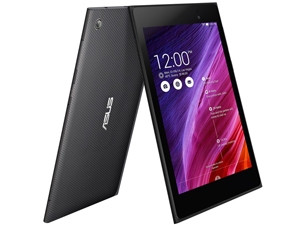
Back in 2012, when Asus was asked to manufacture the Nexus 7 for Google, they produced one of the best budget tablets money could buy. In 2013, Asus managed to create an even better, second-generation version with a nearly identical price tag. Competitive brands, on the other hand, seemed unable to compete with its slim design, fast hardware, great screen, long battery and low manufacturing costs.
Although the production of the Nexus 7 has been discontinued since October last year, and Google decided to team-up with HTC for their latest Nexus tablets, Asus still carries on to produce and market similar devices naming them MeMO Pads. Although there are various configurations available of these MeMO Pads, they're all 7- or 8-inch sized and come with a characteristically low price tag. We received a review-sample of the latest, most high-end version of the Asus MeMO Pad 7 (model ME572C) and got to work with it for a full week. Does it have what it takes to handle your business?
To find that out, and obviously to stack it up similar tablets, we used the Asus MeMO Pad 7 for typical office and business related tasks like browsing, communicating and handling all sorts of documents. To determine the hardware performance and battery life, we ran a set of specialised benchmarks. The quality of the screen was subsequently measured with a professional colorimeter.
Look and feel: plastic fantastic
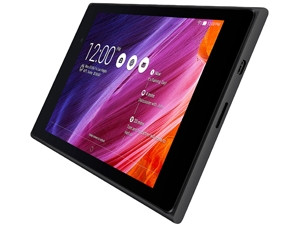
The front of the MeMO Pad 7 looks quite similar to other 7-inch tablet we've come across. It's got relatively thick edges at the top and bottom of the screen, not unlike the Nexus 7, making it somewhat big for a device with a 7-inch screen diagonal. On the positive side, there is lots of parking space for your fingers when holding the MeMO Pad 7 horizontally. The backside of the MeMO Pad 7 is like nothing we've ever seen before. We're not sure what the designers at Asus were thinking, but the rear feels like a clutch handbag as a result of its plastic profile. Despite its plastic exterior, the MeMO Pad 7 feels sturdy enough to survive even the roughest days at the office.
Unlike many other tablets, which have screens that are recessed into their casing, that's not the case with the Asus MeMO Pad 7. Instead, the display is slightly protruding. You can actually feel the transition from screen to the plastic casing when swiping outside in. Without the protruding screen, the tablet would have handled slightly better and even more comfortable.
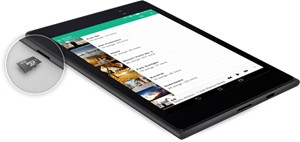
On the right side, just below the volume buttons, there's the inevitable on/off switch while on the left side the MeMO Pad 7 offers a micro-SD card slot. That's a good thing since it makes increasing the scanty 16GB of on-board storage a breeze for every storage hungry business user. The MeMO Pad 7 features two speakers. When holding the device horizontally, there's one on each side. Although that might sound great in theory, in reality the position of your hands tends to muffle the stereo-experience though. Otherwise, the quality of the speakers is pretty good.
Hardware: 22nm Intel quad-core
Asus and Intel have a long history of working together, ultimately resulting in all mobile Asus devices using Intel processors as their beating heart. In this industry, that's quite a unique, loyal symbiosis between two major players. Most companies tend to switch to other parties, like Qualcomm's ARM chips, when it suits them better for financial or technical reasons. Even Apple has been known to switch between Nvidia and AMD GPUs now and then.
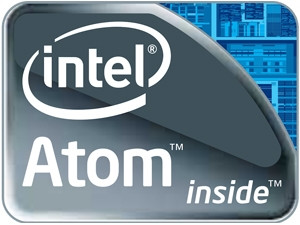
For this specific MeMO Pad 7 model, Asus decided to fit the device with an Intel Atom Z3560 22nm chip that uses four separate cores, each running at a maximum of 1.83GHz. This is a very short, burst-frequency though, so to save energy and generate less heat, the four cores will be running at a much lower frequency of 500 MHz each under normal circumstances. To handle all graphics, our Asus MeMO Pad 7 review sample was equipped with a PowerVR G6430 chip. In theory, those specifications should be more than plenty for typical, and even semi-demanding business users.
Benchmarks: good for business
We obviously wanted to find out how the compact Asus MeMO Pad 7 would perform in real life, so we used our set of dedicated benchmark tests. We ran those benchmarks on the exact same version of the operating system that it was originally supplied with, which is Android 4.4.2. For a pure and honest comparison, we stacked it to seven similar sized tablets from competitive brands.
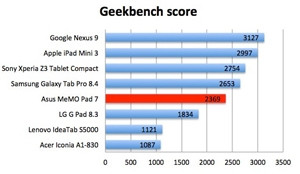
The first benchmark test, Geekbench, simulates real-world business and consumer scenarios to determine and quantify the actual (multi-core) processing power. It made clear that the MeMO Pad 7 couldn't quite catch up to the more expensive 8.9-inch Google Nexus 9, 7.9-inch Apple iPad Mini 3, 8-inch Sony Xperia Z3 Tablet Compact and 8.4-inch Samsung Galaxy Tab Pro.
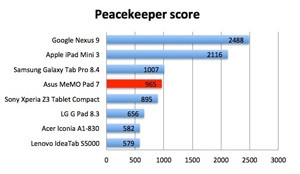
The second benchmark tool, Peacekeeper, also factors in the performance of the operating system and browser, aside from the internal hardware. It mostly confirmed what Geekbench had showed before; the Google Nexus 9 and the iPad Mini 3 easily outperform the Asus MeMO Pad 7. Samsung's Galaxy Tab and Sony's Xperia Z3 Tablet put down nearly identical scores when compared to the MeMO Pad 7.
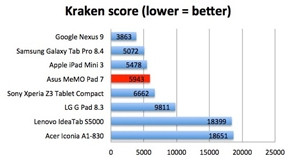
The third tool we used to measure the performance of the Asus MeMO Pad 7 is called Kraken. Like Peacekeeper, it also benchmarks the browser, operating system and internal hardware. Only this time, a lower score is better since the less time it takes the device to complete a set of tasks, the faster the hardware. All test scores are measured in milliseconds (ms). According to Kraken, the MeMO Pad 7 is again unable to beat the Nexus 9, Galaxy Tab Pro and iPad Mini 3 but proves slightly faster than Sony's 8-inch device. It also has no trouble obliterating the 8.3-inch LG G-Pad, 7-inch Lenovo IdeaTab S5000 and the 7.9-inch Acer Iconia A1-830.
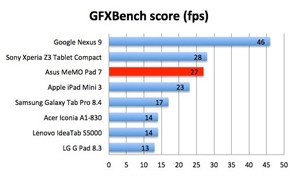
To top it all off, we used the GFXBench software tests to see how long the MeMO Pad 7's GPU (graphical processing unit) would handle complex 3D-graphics. All test scores are measured in frames per second (fps). The more frames a device can render within one second, the faster its hardware. As it turns out, the MeMO Pad 7 manages to finish at a respectable third place. Sony's Z3 Tablet Compact proved marginally faster while the powerful graphics chip of the Nexus 9 puts all other devices to shame.
In the end, the Asus MeMO Pad 7 might not be the best-performing mini-tablet currently available, but it does pack more than enough punch for typical, and even sporadic heavy, graphical business use. Its breaking point becomes evident while installing multiple apps and doing some heavy multitasking, all at the same time. But don't fear, under normal day-to-day office circumstances, the MeMO Pad 7 runs silky smooth and will prove to be a joy to work with.
Battery life: 10 hours for office use
The device is equipped with a 3 950mAh capacity battery, which is fairly standard for a 7-inch tablet. Bigger, and more expensive, tablets like the Google Nexus 9 (6 700mAh) and Apple iPad Mini 3 (6 470mAh) offer considerably larger capacity batteries though.
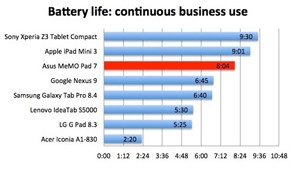
To see how the MeMO Pad 7's battery actually lasts, we used two separate test scenarios. The first test simulates typical office activities like communicating, browsing and editing documents. The second test continuously plays a 1 080p movie until there is no energy left. Both tests aim to drain the battery as fast as possible, effectively creating a worst-case scenario; the minimum time you can expect the device to function.
According to our first test, the Asus MeMO Pad 7's will last for eight straight hours when continuously used for typical office tasks. That's a pretty good score for a low-budget device. Both the more costly Sony Xperia Z3 Tablet Compact and Apple iPad Mini 3 will last more than an hour longer on a fully-charged battery. The Google Nexus 9 could only hold on for six hours and 45 minutes when confronted with business-related tasks.
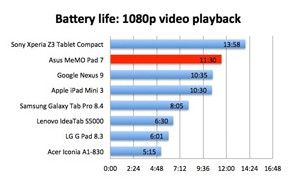
Since a typical day at the office also includes at least one (lunch) break and some idle time, the Asus MeMO Pad 7 will have no trouble working for roughly 10 hours without needing external power.
Even if you plan to watch Full-HD videos in the boss' time, that won't be a problem for the compact MeMO Pad 7. It can display video for 11 hours and 30 minutes, that's more than enough to watch the complete Lord of the Rings trilogy in the plane, while heading to an important business meeting overseas. Only the Sony Z3 is able to outlast the MeMO Pad 7, but then again that device will cost you a lot more.
Screen: excellent for all-round use
As with all budget tablets, technical concessions had to be made at some point to get the price as low as possible. A good way to cut production costs would be to fit it with a lesser screen, so we prepared for the worst in case of this device. Little did we initially know that we had absolutely nothing to worry about.
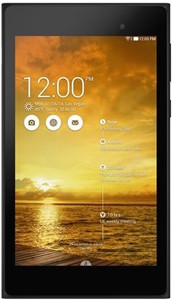
We discovered, with the help of a SpectraCal C6 colorimeter, the 7-inch screen of the Asus MeMO is actually very good. Not only can it show high brightness levels, making it well-suited for the great outdoors, it also displays high contrast levels resulting in vivid and lively colours. The viewing angles are also excellent while the screen shows minimal reflections that would be caused by other light sources, like a bright office light.
The only downside we could find is that the reproduction of colours is just a bit off. Luckily, only users with a very keen eye, or passion for photography, will be able to spot that imperfection. Ultimately, the MeMO Pad 7's screen is very good and will definitely prove more than adequate for all business users, movie lovers, photo enthusiasts and even amateur gamers.
Camera: Achilles heel
Both the 5MP rear camera and the 2MP front camera lack any form of quality. There's no LED-flash to help them in light-deprived situations or optical image stabilisation for that matter. The rear cam does have auto-focus and Asus software tries to manage facial recognition as well as it can, but nothing to really impress. In general, the pictures and video fragments just look average at best and really require as much light as possible to make the most out of them. Its front camera can be used for a 720p Skype-call with a colleague or business contact, but be sure to turn a lamp on or the quality will quickly diminish.
The lack of good camera hardware is partly compensated by the amount of settings to play with, like manual exposure, ISO values and white balance configuration. It also supports high dynamic range (HDR) and burst mode to toy with. Unfortunately, all those extras won't miraculously enhance the overall quality, which clearly is the MeMO Pad 7's Achilles heel.
In the end, the picture and video quality is just enough for the occasional corporate meeting, business trip or birthday party at the office as long ? as you curb your expectations according to the device's price tag.
Verdict
The Asus MeMO Pad 7 proves good tablets don't have to cost a fortune. The device offers solid performance, great battery life and an excellent screen. It's also compact, lightweight and feels pretty durable, which ultimately makes it a perfect companion for the frequently flying business user.
Unfortunately, the meagre 16GB of storage space won't facilitate a lot of (big) files, but at least that problem can be effectively neutralised with an optional SD-card. Its biggest weak spot, however, is the lack of a good front and back camera. Business users who really don't care about that will find the Asus MeMO Pad 7 to be an excellent and affordable mini-tablet.
Share